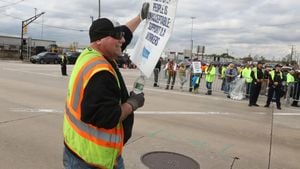Devastation continues to ripple through Spain as the nation grapples with the aftermath of catastrophic floods, which have already claimed the lives of at least 205 people, leaving hundreds missing and many more displaced. The torrential rains, described as unprecedented, hit several regions, particularly affecting areas like Valencia, where images reveal streets transformed by rising waters and debris.
Emergency services and military crews have been deployed extensively. More than 1,200 soldiers are assisting local emergency workers as they scour mud-soaked towns and villages, searching for survivors amid cars piled like toys and homes swallowed by water. Authorities are urging residents to stay indoors to facilitate rescue and recovery operations. The streets are strewn with ruined belongings and devastated families are now tasked with salvaging what they can from their homes.
This extreme weather has not only devastated infrastructure but has also sparked widespread anger and frustration among the affected residents. Many survivors have expressed their dismay at the perceived slow response from the government. Local leaders are being pressured to provide more immediate support and resources to those impacted. Images from the disaster zone show not only the physical devastation but also the emotional toll on families who have lost everything.
Among the hardest hit, the city of Torrent has seen first-hand accounts of horror from those caught in the deluge. One survivor shared their story of clinging desperately to anything solid as rushing water engulfed their neighborhood, inundated within mere minutes. “I never thought it could happen here, so fast, so violently,” they recounted, highlighting the suddenness and ferocity of the flash floods. Many families are now grappling with the reality of starting over, as they sift through the mud for keepsakes and memories.
A recent report indicates emergency services have undertaken step after step to reach the hardest-hit areas, yet frustrations bubble forth as locals see slow progress. Clean-up operations are hindered not just by the sheer volume of water and debris but also by the challenges of accessing isolated regions. Rescuers are finding their efforts hampered by collapsed roads and damaged infrastructure, complicative barriers to reaching those still trapped.
Media coverage of the event has tried to capture the enormity of the tragedy. Pictures of entire neighborhoods submerged have gone viral, igniting outrage and calls for accountability from the government. Critics question the preparedness and response frameworks of local officials when faced with such disasters. “This is not just weather; it’s negligence,” voiced one frustrated resident, encapsulating the sentiment many feel as they confront bureaucratic bottlenecks even during their most desperate moments.
Humanitarian aid is now desperately needed. The growing calls for more tangible support echo across social media platforms, where survivors and their families share their experiences, urging for swift governmental action. Shelters are being set up for those displaced, but with the scale of destruction, resources are quickly running thin. Citizens and organizations are coming together, initiating donation drives and fundraising campaigns to aid those affected.
Despite the outpouring of community support, the logistical nightmare continues to pose significant challenges for first responders. Authorities are calling for the population’s patience as they manage widespread grief alongside logistical hurdles. Recovery is projected to take months, if not years, as the nation digs itself out from the rubble.
Over the next weeks, families will be forced to confront not just the physical scars left by the floods but the much larger emotional toll of their ordeal. Many are left wondering how they will rebuild their lives and whether the government will genuinely heed their calls for help.
The floods have prompted officials to revisit and reevaluate emergency response protocols, hoping to create more effective measures for future crises. Authorities recognize the dire need for enhanced infrastructure resilience to withstand extreme weather events, which are becoming increasingly common due to climate change. This catastrophe may serve as both a wake-up call and catalyst for important changes needed to prepare for future challenges.
While recovery efforts ramp up, the emotional and psychological fallout from the floods will likely linger far longer than the physical cleanup. Schools, businesses, and community centers will require support not only for infrastructure repair but also assistance for the mental health of those impacted. Governments and social organizations must be prepared to address these needs comprehensively.
Spain stands at the crossroads of recovery and resilience; officials must learn from this tragedy to create a foundation for sustainable rebuilding. The public’s patience and continued pressure will be key factors as reconstruction gets underway. Community solidarity is shining through the darkest of times, proving once again the enduring human spirit amid devastation.



